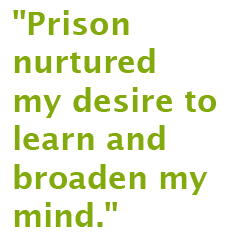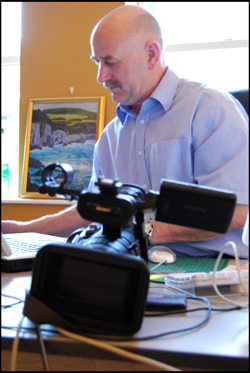 |
| Figures of the Titanic make a novelty chess set in the Solstice art gallery |
As John Nixon glances out the window of Solstice, his second-story art gallery, pedestrians stroll along the sidewalks of Scotch Street in Armagh, shopkeepers perfect their window displays, and burly men haul boxes of food to the markets.
It is difficult to believe that Nixon, who greets his visitors with tea and conversation, once bombed the area.
With a rich history of involvement in the troubles, Nixon opened the Solstice Photography and Art Gallery in July 2007 at 50/52 Scotch Street. The gallery sells vivid oil paintings, charming watercolors, stained glass, and mythical statues that tell the story of Armagh's past, present, and future.
"So here I am, ex-prisoner, ex-blanket man, former hunger striker, activist, sitting here on Scotch Street, which is one of the prime Unionist areas in Armagh, trying to bridge the gap between the two communities through art," Nixon says.
Now approaching his 52 nd birthday, Nixon grew up as one of ten children, five boys and five girls. His father was a farm worker who earned a meager wage but refused welfare and worked long hours to provide for his family.
"We didn't have everything handed to us," Nixon says. "We went out working for ourselves at a very young age, and during the summer months we worked very hard to pay for our school uniforms."
For the first 12 years, Nixon's childhood in Armagh was normal. He grew up in a working class area where Catholics and Protestants lived together in peace under comparatively equal economic circumstances. But by the 1960s, many Protestants had moved out; and by 1970, 95% of the neighbors on John's street, Old Callan Street, were Republican.
"I am of the generation that grew up in Armagh before the troubles and remember and recall living with our Protestant neighbors together," Nixon explains.
But peacetime soon turned to trouble time. At thirteen, Nixon participated in street actions, civil disobedience, and defense of his area from the British army.
At 17, a twist of luck and tragedy changed his life. The same bullet shot Nixon and his friend, James McGerrigan. Although Nixon recovered, James was buried. He was 18 years old.
Immediately afterwards, Nixon was sentenced to prison for possession of firearms and he pleaded "not guilty." Upon release, he was sentenced to 12 more years off and on in Long Kesh prison because he was a member of the INLA (Irish National Liberation Army).
 Nixon was a man of contrasting personalities in prison. He was a hunger striker, a blanket protestor, and, he says, continually beaten by prison guards. He also found time to read.
"That is where my intellect was developed," Nixon says. "Prison nurtured my desire to learn and broaden my mind."
After jail, Nixon attended Queens University in Belfast for five years, where he earned a bachelor of arts in art with honors. For this award he gives credit to his education in jail.
"Jail will beat you if you come into jail full of hatred and bitterness; but if you can turn it around and be positive and use that experience for the benefit of even one person, then you have defeated jail," Nixon says.
 This past year was a monumental year for Northern Ireland with Sinn Fein and the Unionists sharing power. Although the agreement did not fulfill Nixon's original ideals, such as a united Ireland, the agreement does have its benefits.
"It furnished us with the ability to interpret our history in our own way, to write our own history, rather than leave it to the historians," Nixon reflects.
Although Ireland and her people have suffered during the troubles, some beauty has emerged from their pain.
"What did 300 years of peace in Switzerland produce?" Nixon asks. "A cuckoo clock. Thirty years of conflict, murder, mayhem, what did it produce here? It produced a lot of soul searching, activism, academics, artists, writers, and musicians."
If Ireland had not experienced such turmoil, Nixon believes that creative talent would have emerged more slowly and ordinarily. Through tragedy, people found ways to use their artistic expression.
"Now we're in the post-peace process, and what you see now is a new emergence of art, and it's not the art of the conflict and struggle, it is the art of peace," Nixon explains. "The best examples of this are the murals throughout Northern Ireland. The murals are barometers of change."
 Nixon points out that twenty years ago, the murals reflected atrocities, murder, and resistance, but today they depict change, peace, adaptation, and a search for cultural identity.
"They reflect the ongoing and changing climate this year," Nixon says slowly and deliberately. "So all along, even though we had violence, killings, raids, incarceration, torture, alongside this here, there remained alive the artistic soul."
Since the aftermath of the troubles, Nixon says more young people desire to master the Irish language. Though the troubles shaped Ireland into what she is today, Nixon welcomes the peace.
"I wouldn't want any young people to go through what I went through. I wouldn't want any other generation to go through the experiences of loss of liberty, loss of the best years of life, loss of life itself," he said. "Nor would I want them to carry that baggage of hatred, acrimony, desire for revenge. I wish for young people to harness my experience to steer around from violence, to steer into a more peaceful mode of achieving things."
Aside from his involvement in the arts, Nixon has recently stood for local elections but was not elected.
"John is well-respected in the Republican community because of his leadership in the past," says Sean McGerrigan, director of the Cathedral Road Community Recreational Center in West Armagh. "But he has made a few Nationalist enemies because he ran as an independent against Sinn Fein on two occasions."
McGerrigan, the brother of the late James McGerrigan, has known Nixon since childhood.
"John would do anything for you if you just ask; he put time and effort into this community center," McGerrigan said while pointing to the black and white photographs that covered the walls.
 |
| John's friendly manner makes all customers feel welcome |
Nixon and McGerrigan founded the West Armagh Festival together. The festival takes place annually on the 9 th of August.
Nixon's American wife, Toni, said that business in the Solstice gallery has increased since its opening two weeks ago. The artists who exhibit their work at Solstice are from Armagh and represent various political parties.
"As a man involved in the arts, I desire to bridge that gap between what is perceived to be a class culture and to help people from working class areas who are involved in conflict to see that everything, no matter what it may be, can find some expression in some artistic form," Nixon says.
The Solstice Art Gallery & Studio is located at 50/52 Scotch Street, Armagh, BT61 70F.
Tel: (028) 37527047 / (028) 37518863. E-mail: e.virnoche@btinternet.com.
Story by Charlotte Levins
Photos by Sarah Turner
Video by Cate Oliver
Web Design Roisin Kelly |

